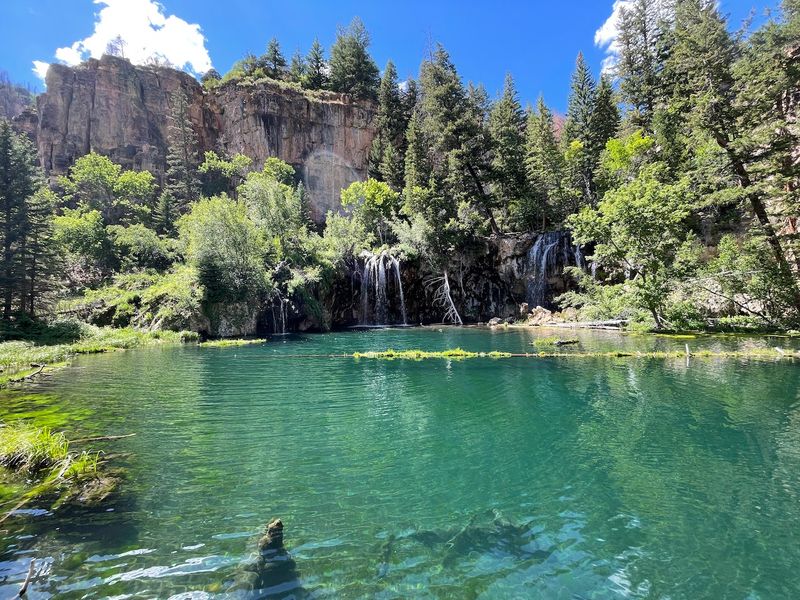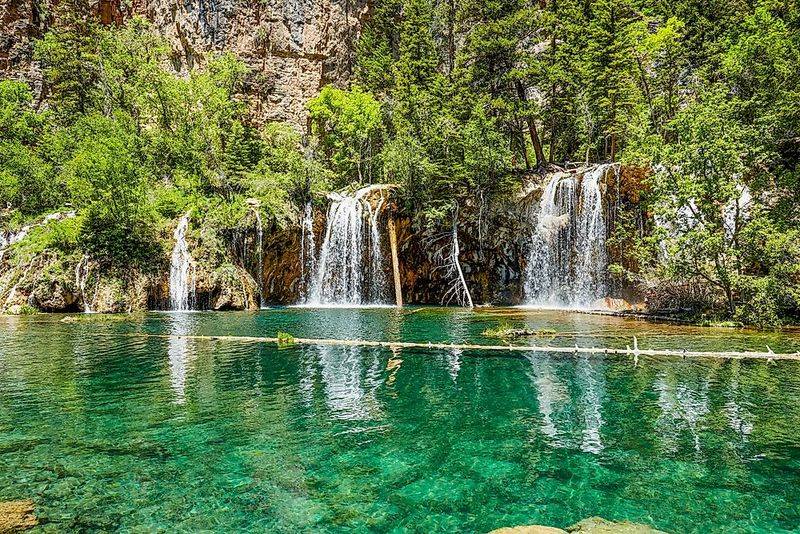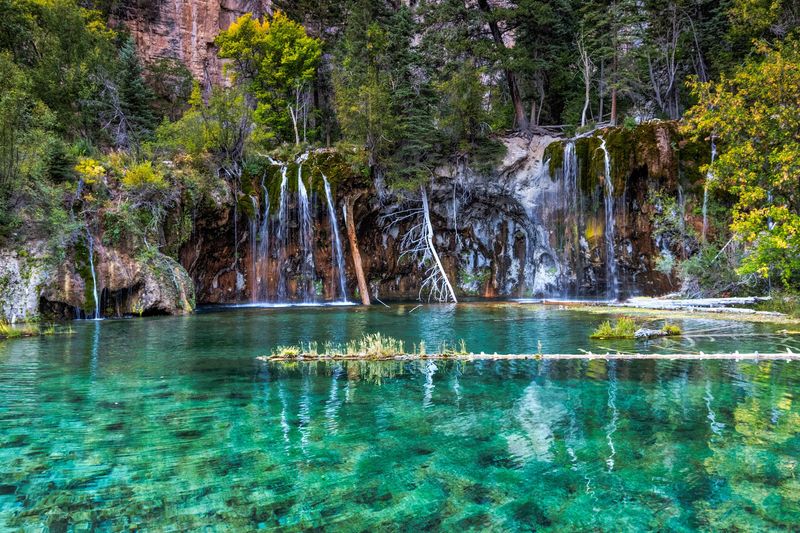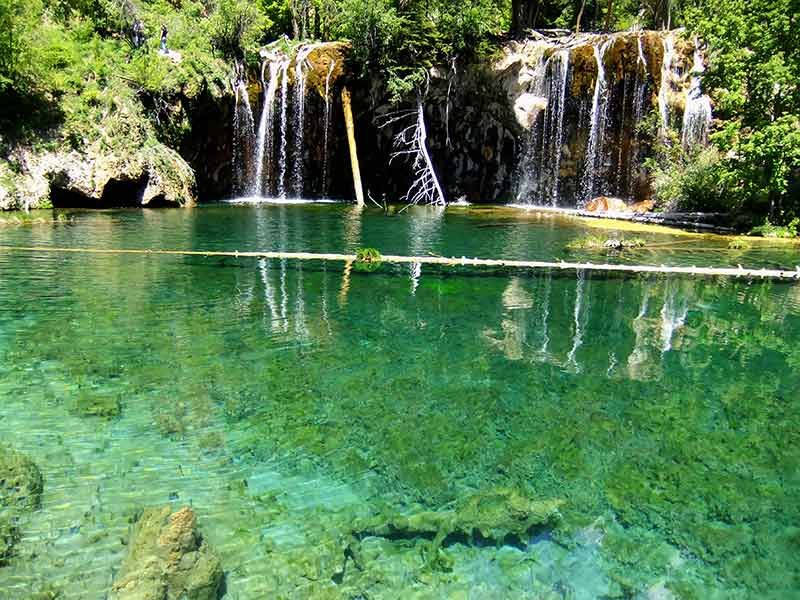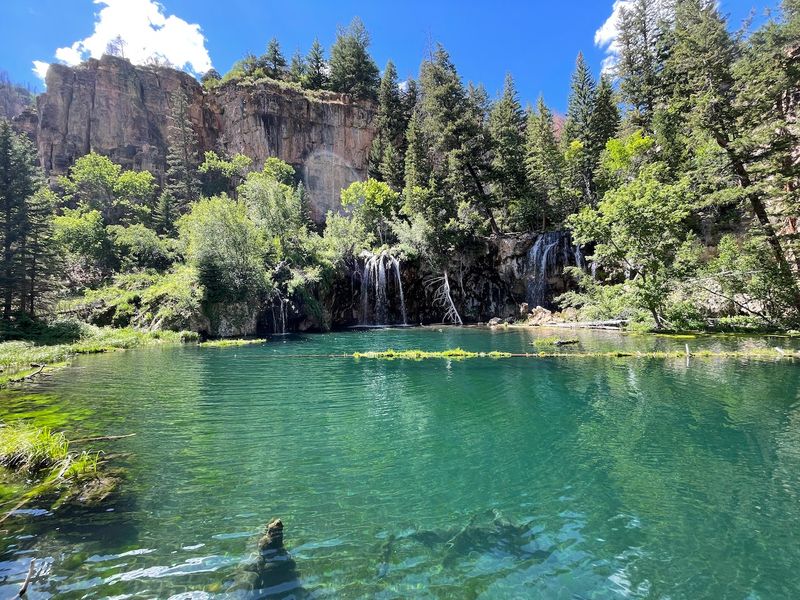Tucked away in the cliffs of Colorado’s Glenwood Canyon, Hanging Lake appears almost impossible—a brilliant turquoise pool perched on the side of a rocky wall. Fed by waterfalls and framed by delicate mineral formations, this natural wonder has captivated hikers and nature lovers for over a century. Its beauty is as fragile as it is stunning, making every visit a lesson in both awe and respect.
Perched Above the Canyon
On the steep walls of Glenwood Canyon, the lake sits like a jewel suspended above the valley floor. A gold prospector stumbled upon this hidden basin in the late 1800s, and it later became part of a private homestead.
Glenwood Springs acquired the land in 1910, and today it rests within the White River National Forest. The trail winds up about 1,000 feet in elevation over roughly 1.2 miles, arriving at a crystal-clear pool framed by travertine edges and falling streams.
The name “Hanging Lake” reflects its elevated, almost precarious position—a lagoon seemingly fixed to a cliffside, with waterfalls feeding its vivid turquoise surface. This unique geography sets the scene for something both fragile and spectacular.
A Geologic and Visual Wonder
Hanging Lake’s turquoise color comes from high levels of dissolved mineral carbonates—primarily limestone and travertine deposits—that give the water its vivid hue and mirror-like clarity. The shoreline formed over thousands of years by deposits of travertine from the flowing water of Dead Horse Creek.
These delicate formations are still growing, making the entire basin a living geologic process. Beyond color, the setting is rare: waterfalls pour into the lake, and one spot known as “Spouting Rock” jets from holes in the canyon wall just behind the basin.
Because of its uniqueness and ecological vulnerability, the site was designated a National Natural Landmark, recognizing its extraordinary geologic significance and fragile beauty.
Footpath, Permits and Protection
With rising popularity comes rising pressure on the ecosystem. The trailhead is reached just off Interstate 70, about seven miles east of Glenwood Springs, but due to high visitor demand and ecosystem fragility, access is permit-based.
The hike climbs roughly 1,000 feet in elevation over about 1.2 miles—steep and moderate in difficulty. Swimming, wading or otherwise disturbing the water or travertine shoreline is strictly prohibited: even body oils or sunscreen can damage the travertine formation process.
Trail closures, seasonal restrictions and shuttle systems are part of the ongoing effort to balance access and conservation. Reservations fill quickly, especially during peak summer months, so planning ahead is essential for anyone hoping to visit.
Why It Resonates and What to Respect
Hanging Lake is more than a scenic photo-stop—it’s a micro-ecosystem of rare geology, mineral-rich water, alpine forest and canyon hydrology. Its suspended feel, luminous color and dramatic setting evoke a sense of wonder: a pond in the rock, fed by unseen springs and waterfalls, held in place by geologic faulting.
For visitors, the experience blends effort and reward: the trail demands, the destination delights. And yet it carries a reminder that beauty is often fragile.
The rules—permits, no swimming, stay on trail—aren’t nuisances, they’re safeguards. To go there is to witness nature’s balance and to enter a place where the cliffside holds a mirror to its own formation and to our responsibility as stewards.
The Waterfalls That Feed the Dream
Waterfalls are the lifeblood of Hanging Lake, pouring constantly into the basin and maintaining its ethereal appearance. Bridal Veil Falls is one of the most iconic, tumbling gracefully over moss-covered rocks into the shimmering pool below.
Another remarkable feature is Spouting Rock, where water bursts through fissures in the cliff face, creating a curtain of spray that visitors can walk behind. These falls aren’t just beautiful—they’re essential to the lake’s ecosystem, carrying dissolved minerals that build the travertine shelves and keep the water chemistry balanced.
Without this continuous flow, the lake would lose its color and clarity. Watching the water cascade down, you realize this place isn’t static—it’s constantly reshaping itself, one drop at a time.
A Century of Discovery and Change
When a gold prospector first encountered Hanging Lake in the 1880s, it was a secret tucked deep in the canyon, known only to a handful of locals. The area remained privately owned for years, used as a homestead before Glenwood Springs purchased it in 1910.
Over the decades, word spread, and what was once an obscure mountain pool became one of Colorado’s most beloved destinations. By the mid-20th century, the trail was established, and visitors began flocking to witness the turquoise marvel for themselves.
Today, the lake faces new challenges—overuse, environmental wear and climate shifts. Its history reminds us that protecting natural wonders requires vigilance, adaptation and a willingness to evolve our relationship with the land we love.
The Science Behind the Color
Ever wonder why Hanging Lake looks like liquid gemstone? The answer lies in chemistry. Water flowing from Dead Horse Creek carries high concentrations of calcium carbonate, dissolved from surrounding limestone bedrock.
When this mineral-rich water reaches the lake, it deposits travertine along the edges and bottom, creating a white, reflective surface. Sunlight filtering through the water scatters off these particles, producing that signature turquoise glow.
The purity of the water also plays a role—free from sediment and algae, it remains crystal-clear year-round. Scientists call this process “carbonate precipitation,” but visitors just call it magic. Understanding the science doesn’t diminish the wonder; it deepens it, revealing how geology and hydrology conspire to create something unforgettable.
Planning Your Visit Wisely
Visiting Hanging Lake requires more than just showing up—it demands preparation and respect. First, secure a permit through the official reservation system, ideally weeks or even months in advance, especially if you’re planning a summer trip.
Arrive early to catch a shuttle from the designated parking area, as private vehicles are no longer allowed at the trailhead. Wear sturdy hiking boots, bring plenty of water, and pack snacks for the steep climb.
Leave pets at home, as they’re not permitted on the trail. Most importantly, follow all posted rules: stay on designated paths, don’t touch the water or travertine, and pack out all trash. A little planning ensures you enjoy the experience while helping preserve this fragile wonder for future generations.

